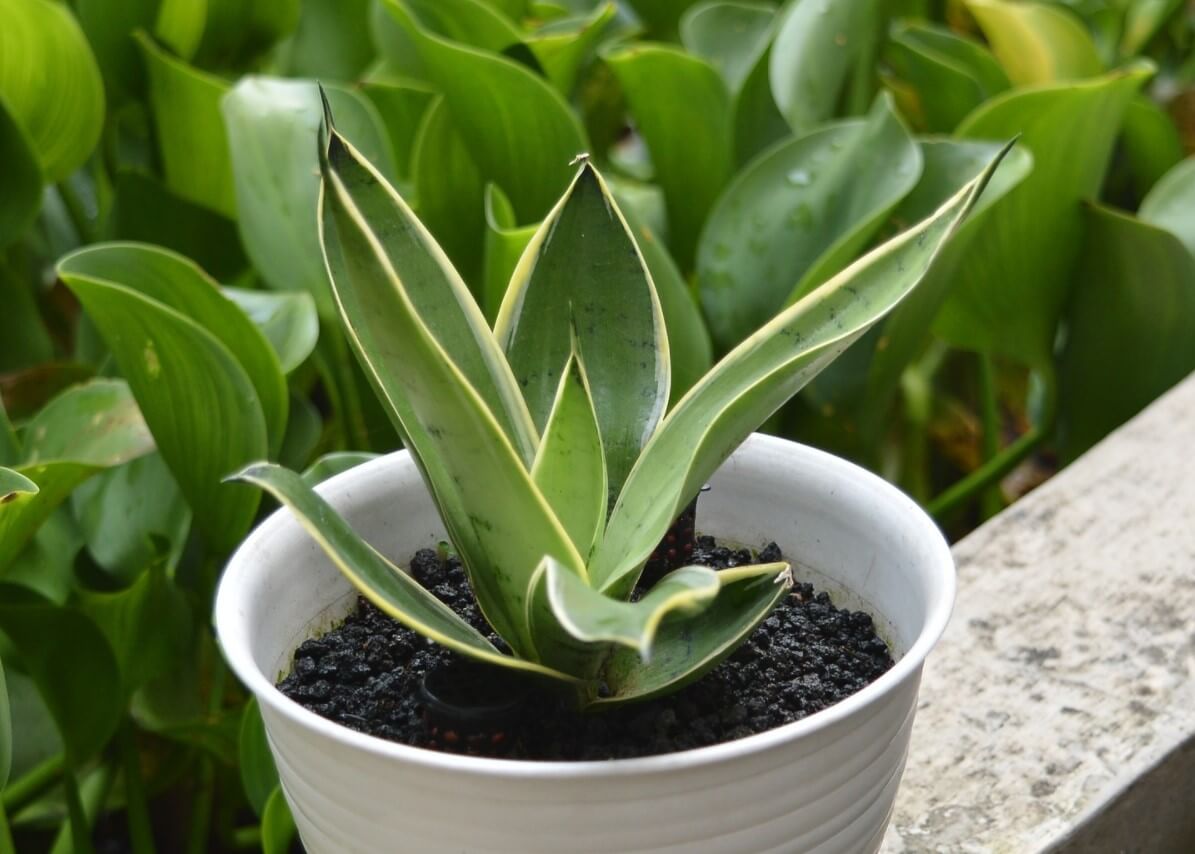There are many reasons why someone might want to grow a snake plant. For one, they look beautiful and easy to care for. They also improve the air quality in your home, according to NASA’s clean air study.
And if there are any pests or diseases that affect your snake plant, you’ll be able to deal with them quickly and easily.
However, there are common challenges people have when growing a healthy snake plant.
I’ve been there, too. It can be really tough trying to figure out how to grow a snake plant successfully. But don’t worry, you’re not alone. I’m here to help you out. In this article, I’ll share with you how to grow a snake plant successfully.
In this post
- 1. Choose the right pot for your snake plant
- 2. Choose the right soil for your snake plant
- 3. Water your snake plant correctly
- 4. Fertilize your snake plant correctly
- 5. Prune your snake plant as needed
- 6. Deal with pests and diseases on your snake plant
- 7. Repot your snake plant when necessary
- Conclusion
- FAQ
1. Choose the right pot for your snake plant
When choosing a pot for a snake plant, the size of the plant is an important consideration. The pot should be large enough to accommodate the snake plant’s root system and allow for some growth.
Additionally, it is important to ensure that the pot has adequate drainage holes to prevent waterlogging.
Snake plants are also relatively tolerant of different materials, so choosing a pot made from clay, plastic, or metal is typically fine.
However, if you plan to place the snake plant outdoors, it is important to choose a material that can withstand the elements.
Ultimately, choosing the right pot for your snake plant will help to ensure its health and vitality.
2. Choose the right soil for your snake plant
Choosing the right soil for your snake plant is important for the health of the plant. The soil should be well-drained to prevent waterlogging, have a high organic matter content to provide nutrients, and be pH-neutral or slightly acidic to discourage pests and diseases.
You can buy potting mix specifically designed for snake plants, or you can make your own by mixing equal parts sand, peat moss, and perlite.
If you choose to make your own potting mix, be sure to add a slow-release fertilizer to provide nutrients throughout the growing season.
With a little care and attention, you can create the perfect environment for your snake plant to thrive.
What is the proper pH for Snake Plant?
Snake plants are tolerant of a wide range of soil pH levels, but prefer a pH of between 4.5 and 7.0.
A pH level outside of this range can impede the plant’s ability to absorb nutrients from the soil, which can hinder growth or cause other problems.
If you are unsure what your soil’s pH levels are, you can test them using a home testing kit.
You can also adjust your soil’s pH levels by adding organic matter or alkaline materials such as lime, ashes, or coffee grounds. (Yes, they like coffee too.)
3. Water your snake plant correctly
Watering your snake plant correctly is important for the health of the plant. The soil should be kept moist, but not wet.
You can water your snake plant by either watering the soil directly or by spraying the leaves with water. Be sure to avoid getting water on the flowers or buds, as this can cause them to rot.
How often do I need to water my snake plant?
Snake plants don’t like to be over-watered, so you only need to water them every other week.
The best way to tell if your snake plant needs watering is to check the soil. If the top inch of soil is dry, then it’s time to water your plant.
You can either use a watering can or pour a small amount of water directly onto the soil. Be sure not to overwater your snake plant, as this can cause root rot.
4. Fertilize your snake plant correctly
Fertilizing your snake plant has a number of benefits. For one, it provides the plant with additional nutrients that can help it to grow more quickly and reach its full potential.
It can also help to improve the plant’s resistance to pests and diseases, making it more likely to thrive in the long-term.
Fertilizing can also help to improve the plant’s appearance, resulting in brighter foliage and more vibrant blooms.
If you decide to fertilize your snake plant, be sure to use a fertilizer that is specifically designed for succulents or cacti. But if you are unsure of what kind of fertilizer to use, a general-purpose fertilizer will do the trick.
Please note that over-fertilizing can damage the plant, so it is important to follow the directions on the fertilizer label carefully.
How often to fertilize snake plant
The best time to fertilize your snake plant is in the spring, before the growing season begins, and in the summer, when the plant is actively growing.
Fertilizing your snake plant twice a year will help ensure it has the nutrients it needs to grow while keeping it from over-fertilizing.
5. Prune your snake plant as needed
Pruning your snake plant is an important part of care and maintenance. It helps to keep the plant healthy and looking its best, and can also help to prevent pests and diseases from taking hold.
Pruning also encourages new growth, so it’s a good way to keep your snake plant looking fresh and vibrant.
When to prune snake plant
Snake plants or sansevieria do well when they are actively growing, so the best time to prune them is during the spring and summer.
How to prune snake plant
Pruning your snake plant is easy to do and only requires a sharp pair of scissors or gardening shears.
Just make sure to use clean shears and disinfect them between cuts to prevent any disease from spreading.
Start by removing any dead or dying leaves, then trim back any overgrown leaves.
You can also either cut off a leaf or two at the base of the plant or make more drastic cuts to reshape the plant.
Once you have finished pruning, it’s important to dispose of the trimmings in a way that will not attract pests or diseases.
6. Deal with pests and diseases on your snake plant
Pests and diseases can be a major problem for snake plants, as they can damage or kill the plant. So, it’s important to be on the lookout for signs of pests or diseases, and to deal with them swiftly if they occur.
The most common pests that affect snake plants are scale insects, mealybugs, and spider mites.
These pests can all be controlled with regular applications of insecticidal soap or neem oil.
If you notice any signs of pests or diseases on your snake plant, be sure to act quickly and sprayed the plant with an appropriate insecticide or fungicide.
Read our guide on Snake Plant Pests and Diseases here.
7. Repot your snake plant when necessary
As your snake plant grows, it will eventually outgrow its current pot. When this happens, you will need to repot the plant into a larger pot.
How to repot snake plant
Repotting your snake plant is easy to do and only requires a few supplies. You will need a new, larger pot, some fresh potting mix, and some pebbles or gravel.
- Start by removing the plant from its current pot and gently shaking off any excess soil.
- If the plant is pot-bound, you may need to loosen the roots a bit before replanting.
- To help drainage, add a layer of pebbles or gravel to the bottom of the pot.
- Next, add some fresh potting mix to the new pot and place the snake plant in it. Gently firm the soil around the plant and water well.
- Place the pot in a bright, sunny spot and water as needed.
Conclusion
Growing a snake plant can be easy if you follow these simple tips. Choose the right pot and soil, water and fertilize it correctly, and prune as needed. If pests or diseases occur, deal with them accordingly. Repot your snake plant when necessary to keep it healthy and looking its best.
FAQ
Q. How often should I water my snake plant?
A. Water your snake plant when the soil is dry to the touch and avoid overwatering, as this can lead to problems such as root rot.
Q. How often should I fertilize my snake plant?
A. Fertilize your snake plant once or twice a year, in the spring and summer, to help ensure it has the nutrients it needs to grow.
Q. How do I deal with pests on my snake plant?
A. If you notice any signs of pests on your snake plant, be sure to act quickly and sprayed the plant with an appropriate insecticide or fungicide. You can also try using home remedies such as neem oil or insecticidal soap.
Q. How do I know when it’s time to repot my snake plant?
A. Repot your snake plant when it has outgrown its current pot or if the roots are pot-bound. You will know it is time to repot when you see new growth emerging from the drainage holes in the pot.
Q. How can I make my snake plant grow faster?
A. Snake plants typically grow quite slowly, so there is no need to fertilize more than once or twice a year. You can also try propagating your snake plant to create new plants.
Q. How do I propagate my snake plant?
A. Snake plants can be propagated by division or by rooting leaf cuttings in water or soil.
Q. What are the benefits of growing a snake plant?
A. Snake plants are easy to care for, drought tolerant, and can help purify the air in your home by removing toxins such as formaldehyde and carbon dioxide.

